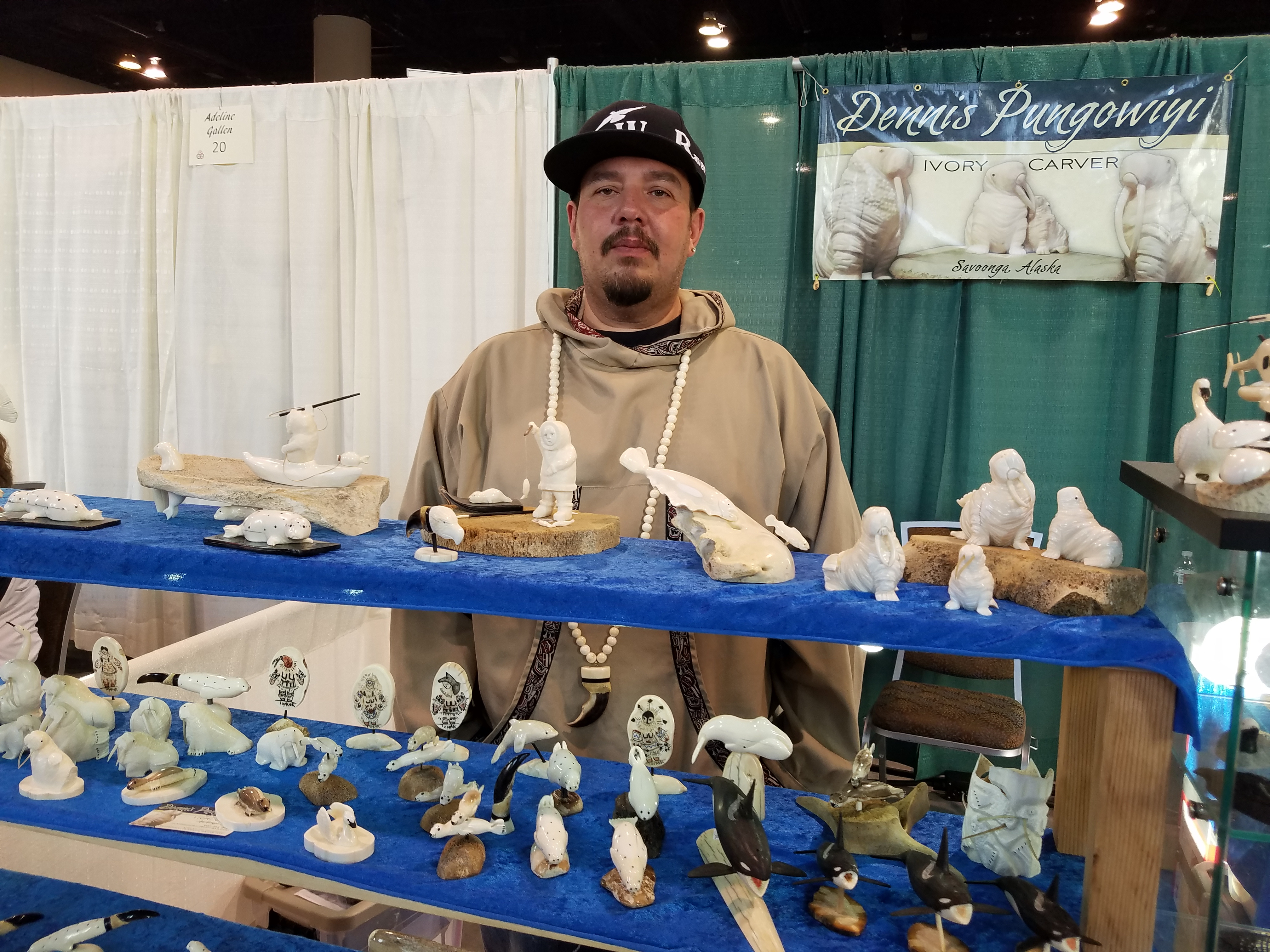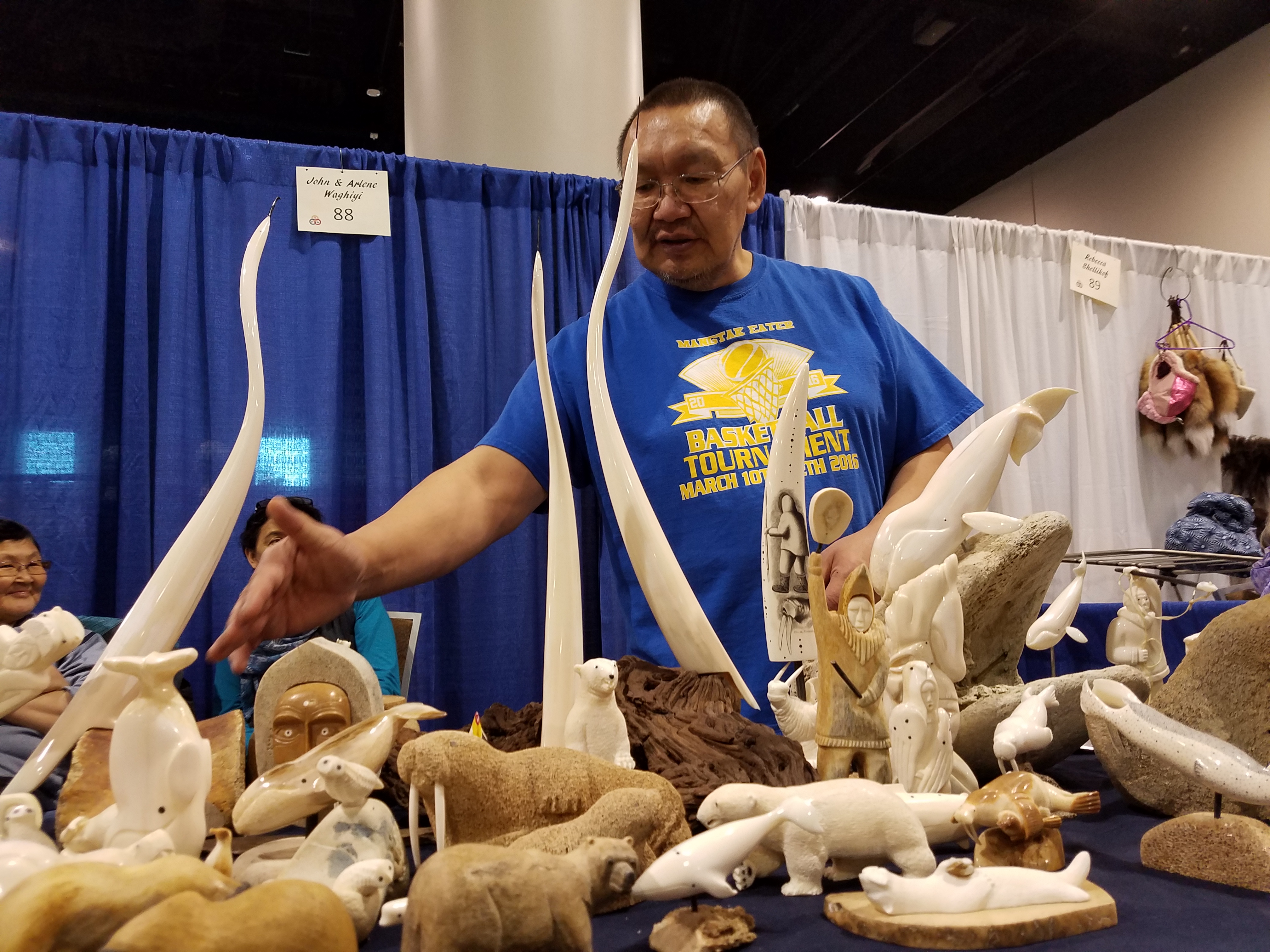Some U.S. state ivory bans affect Alaska Native carvers. A new federal bill aims to override them.

Dennis Pungowiyi, an Alaska Native from St. Lawrence Island in the icy Bering Sea, lives a world away from the African savannas, yet global concerns about elephant poaching there have caused collateral damage to the walrus ivory carver’s business.
In a typical summer, said Pungowiyi, who hails from the Siberian Yupik village of Savoonga, said he sells five to 10 small walrus figurines — one of his specialty ivory products — each week in a store in Anchorage.
“Last year I sold maybe three, total, in the whole summer,” said Pungowiyi, who was presided over a booth at the arts and crafts fair set up at the annual Alaska Federation of Natives convention in Anchorage last week.
Tourists are shying away from his work, he said, “because people are worrying and thinking that walrus ivory is illegal.”
It is not, and Alaska Natives have the right, under the Marine Mammal Protection Act, to sell artwork made from the ivory of legally hunted walruses. But Alaska ivory carvers say they have been inadvertently harmed by a crackdown on the illegal trade of ivory from highly endangered elephants.
Now both of Alaska’s U.S. senators have introduced federal legislation that would explicitly prohibit U.S. states from banning sales of products made from walrus ivory or those made from whale bones or from fossilized mammoth or mastodon ivory.
The bill is called the “Allowing Alaska to Improve Vital Opportunities in the Rural Economy Act” or the “Allowing Alaska IVORY Act.”
Ivory bans in the Lower 48, though aimed at the important goal of protecting the much-jeopardized African elephant, have had unintended consequences, Sen. Lisa Murkowski told reporters on Saturday at the AFN conference in Anchorage.
“We recognize here in Alaska that all ivory is not African elephant ivory,” she said. “When you have states that enact bans based on, I think, an ignorance of the distinction between the ivory, what that then does, it chills the opportunity for the Alaska Native artisans.”
Introduction of the bill follows a field hearing held by Sullivan at last year’s AFN convention and outreach by the senators to leaders outside of Alaska.
That outreach includes an Oct. 17 letter about the matter to the heads of the National Conference of State Legislatures and the National Governors Association.
Last year, Murkowski sent a letter to California Gov. Jerry Brown that asked whether that state’s ban on ivory possession and sales could be clarified to exempt traditional Native handicrafts that are legal under the Marine Mammal Protection Act. In the letter, she noted that the California law does have some exemptions, but not for traditional indigenous artwork. (In addition to California, the states of New York, New Jersey and Hawaii have enacted ivory bans that affect traditional Alaska Native carvings.)
The Alaska IVORY bill, however, would go beyond requests. It would prohibit any state from banning sales, transfers, trades or possession of handicrafts made of walrus ivory, whale bone, fossilized mammoth ivory or fossilized mastodon ivory — as long as those items are authentic Native handicrafts.
The bill raises a constitutional question: Could Congress restrict what state legislatures allow or prohibit?
Sullivan says yes. In a roundtable discussion at the AFN conference, he cited the U.S. Constitution’s commerce clause, which protects interstate commerce.
“There’s provisions in the U.S. constitution that say states can’t ban products of other states,” he said.
“The federal government may in certain circumstances preempt state law,” read a subsequent statement from his office.

Meanwhile, there are efforts by the U.S. Fish and Wildlife Service and others to spread the word that walrus ivory products are very different from those made out of elephant ivory, the statement said. “FWS has partnered with Alaska Native co-management groups and corporations to develop materials on this and there is discussion with the cruise ship industry to help push the information out to tourists,” it said.
Another ivory artist selling his work at the AFN conference, John Waghiyi of Savoonga, said he was happy to learn about the legislation introduced by the senators. “They’re good people,” Waghiyi said.
He stressed that Alaska Native walrus hunters use the entire animal, and said the walrus provides for his people “physically and spiritually.” The artwork made from ivory tusks is part of something that “predates history,” he said.
“It’s not for head-hunting or poaching purposes. It’s to continue our subsistence way of life,” he said on Friday. “You know what I had for lunch today? Frozen baby walrus.”